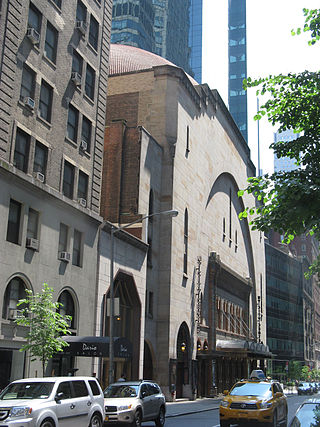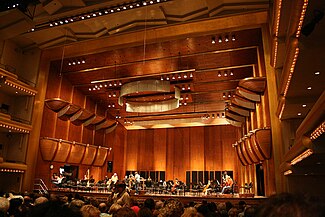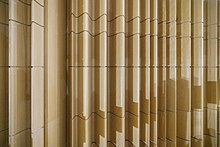
The New York Philharmonic, officially the Philharmonic-Symphony Society of New York, Inc., globally known as New York Philharmonic Orchestra (NYPO) or New York Philharmonic-Symphony Orchestra, is a symphony orchestra based in New York City. It is one of the leading American orchestras popularly called the "Big Five". The Philharmonic's home is David Geffen Hall, at New York's Lincoln Center for the Performing Arts.

Carnegie Hall is a concert venue in Midtown Manhattan in New York City. It is at 881 Seventh Avenue, occupying the east side of Seventh Avenue between West 56th and 57th Streets. Designed by architect William Burnet Tuthill and built by industrialist and philanthropist Andrew Carnegie, it is one of the most prestigious venues in the world for both classical music and popular music. Carnegie Hall has its own artistic programming, development, and marketing departments and presents about 250 performances each season. It is also rented out to performing groups.

Lincoln Center for the Performing Arts is a 16.3-acre (6.6-hectare) complex of buildings in the Lincoln Square neighborhood on the Upper West Side of Manhattan. It has thirty indoor and outdoor facilities and is host to 5 million visitors annually. It houses internationally renowned performing arts organizations including the New York Philharmonic, the Metropolitan Opera, the New York City Ballet, the Chamber Music Society of Lincoln Center, and the Juilliard School.
Avery Robert Fisher was an amateur violinist, a pioneer in the field of high fidelity sound reproduction, founder of the Philharmonic Radio Company and Fisher Electronics, and a philanthropist who donated millions of dollars to arts organizations and universities.

Cooper Hewitt, Smithsonian Design Museum is a design museum housed within the Andrew Carnegie Mansion in Manhattan, New York City, along the Upper East Side's Museum Mile. It is one of 19 museums that operate within the Smithsonian Institution and is one of three Smithsonian facilities located in New York City, the other two being the National Museum of the American Indian's George Gustav Heye Center in Bowling Green and the Archives of American Art New York Research Center in the Flatiron District. Unlike other Smithsonian museums, Cooper Hewitt charges an admissions fee. It is the only museum in the United States devoted to historical and contemporary design. Its collections and exhibitions explore design aesthetic and creativity from throughout the United States' history.

Lynn Harrell was an American classical cellist. Known for the "penetrating richness" of his sound, Harrell performed internationally as a recitalist, chamber musician, and soloist with major orchestras over a career spanning nearly six decades.

Alice Tully Hall is a concert hall at the Lincoln Center for the Performing Arts in the Upper West Side neighborhood of Manhattan in New York City. The hall is named for Alice Tully, a New York performer and philanthropist whose donations assisted in the construction of the hall. Tully Hall is located within the Juilliard Building, a Brutalist structure, which was designed by architect Pietro Belluschi. It was completed and subsequently opened in 1969. Since its opening, it has hosted numerous performances and events, including the New York Film Festival. Tully Hall seats 1,086 patrons. It is the home of the Chamber Music Society of Lincoln Center.

The Vivian Beaumont Theater is a Broadway theater in the Lincoln Center complex at 150 West 65th Street on the Upper West Side of Manhattan in New York City. Operated by the nonprofit Lincoln Center Theater (LCT), the Beaumont is the only Broadway theater outside the Theater District near Times Square. Named after heiress and actress Vivian Beaumont Allen, the theater was one of the last structures designed by modernist architect Eero Saarinen. The theater shares a building with the New York Public Library for the Performing Arts and contains two off-Broadway venues, the Mitzi E. Newhouse Theater and the Claire Tow Theater.
Horacio Gutiérrez is a Cuban-American classical pianist known for his performances of works in the Romantic Repertoire.
Philharmonic Hall also known as Philharmonie refers to concert halls that have an in-house orchestra:

Ida Levin was an American concert violinist. Levin taught at the Sander Vegh International Chamber Music Academy in Prague and was a former faculty member of Harvard University, the Colburn School and the European Mozart Academy.

Yuja Wang is a Chinese pianist. Born in Beijing, she began learning piano there at age six, and went on to study at the Central Conservatory of Music in Beijing and the Curtis Institute of Music in Philadelphia.

Daniil Olegovich Trifonov is a Russian pianist and composer. Described by The Globe and Mail as "arguably today's leading classical virtuoso" and by The Times as "without question the most astounding pianist of our age", Trifonov's honors include a Grammy Award win in 2018 and the Gramophone Classical Music Awards' Artist of the Year Award in 2016. The New York Times has noted that "few artists have burst onto the classical music scene in recent years with the incandescence" of Trifonov. He has performed as soloist with such orchestras as the Philadelphia Orchestra, New York Philharmonic, Cleveland Orchestra, Royal Philharmonic Orchestra, London Symphony Orchestra, Mariinsky Theatre Orchestra, Royal Concertgebouw Orchestra, Berlin Philharmonic, San Francisco Symphony, Montreal Symphony Orchestra, Houston Symphony and the Munich Philharmonic, and has given solo recitals in such venues as Royal Festival Hall, Carnegie Hall, John F. Kennedy Center for the Performing Arts, Berliner Philharmonie, Théâtre des Champs-Élysées, Concertgebouw, and the Seoul Arts Center.

New York City Center is a performing arts center at 131 West 55th Street between Sixth and Seventh Avenues in the Midtown Manhattan neighborhood of New York City. Developed by the Shriners between 1922 and 1924 as a Masonic meeting house, it has operated as a performing arts complex owned by the government of New York City. City Center is a performing home for several major dance companies as well as the Manhattan Theatre Club (MTC), and it hosts the Encores! musical theater series and the Fall for Dance Festival annually.

Anna Sigríður Þorvaldsdóttir is an Icelandic composer. She has been called "one of Iceland's most celebrated composers", and was the 2012 winner of the Nordic Council Music Prize. Her music is frequently performed in Europe and in the United States, and is often influenced by landscapes and nature.
Mark Peskanov is an American virtuoso violinist, known as a soloist, chamber musician, composer, conductor, and concert presenter.
Michael Stephen Brown is an American classical pianist and composer. He is the recipient of the 2015 Avery Fisher Career Grant, 2018 Emerging Artist Award from Lincoln Center, and the 2010 Concert Artists Guild Competition. Brown has performed as soloist with the Seattle, Grand Rapids, North Carolina, Maryland and Albany symphony orchestras, and at Carnegie Hall, Caramoor, the Smithsonian, Alice Tully Hall, and the Gilmore Festival. He is an artist at the Chamber Music Society of Lincoln Center, and is a former member of CMS Two. He regularly performs duo recitals with cellist Nicholas Canellakis. He has received commissions from many organizations and some of today’s leading artists, and recently toured his own Piano Concerto around the US and Poland with several orchestras.

The Philam Life Theater, also styled Philamlife Theater, was a performing arts venue at 1440 United Nations Avenue in the Ermita district of Manila, the Philippines. It opened in 1961 as the Philam Life Auditorium and was designed by Filipino architect Carlos Arguelles as part of the corporate headquarters for the Philam Life insurance company. The International Style concert hall in the eastern annex of the Philam Life Building is known for its superior acoustics and elegant interior. It served as Manila's cultural center for almost a decade and has played host to world-renowned musicians, choirs and symphony orchestras over its 53-year history, including Renata Tebaldi, Franco Corelli, Marian Anderson, Pinchas Zukerman and Cecile Licad. The theater also served as the home of the Manila Symphony Orchestra, the Manila Philharmonic Orchestra and the Philippine Educational Theater Association.
Randall Goosby is an American concert violinist. He is the recipient of the 2022 Avery Fisher Career Grant and was the first prize winner of the Young Concert Artists International Auditions in 2018.





















